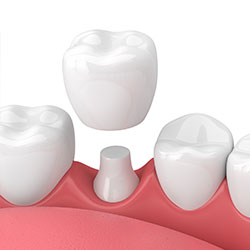
Crowns are a cosmetic restoration used to strengthen a tooth or improve its shape. Crowns are most often used for teeth that are broken, worn, or partially destroyed by tooth decay.
Crowns are "cemented" onto an existing tooth and fully cover the portion of your tooth above the gum line. In effect, the crown becomes your tooth's new outer surface. Crowns can be made of porcelain, metal, or both. Porcelain crowns are most often preferred because they mimic the translucency of natural teeth and are very strong.
Crowns or onlays (partial crowns) are needed when there is insufficient tooth strength remaining to hold a filling. Unlike fillings which apply the restorative material directly into your mouth, a crown is fabricated away from your mouth. Your crown is created in a lab from your unique tooth impression which allows a dental laboratory technician to examine all aspects of your bite and jaw movements. Your crown is then sculpted just for you so that your bite and jaw movements function normally once the crown is placed.
The SMART Method for Safely Removing Metal Fillings
Metal fillings often contain approximately 50% mercury, and many scientific studies have shown unequivocally that mercury at any amount is unsafe for humans. Sedona Smiles is a mercury-free office dedicated to the health and wellness of all patients and team members and utilizes the most up-to-date information to provide quality care that exceeds minimum safety standards. The International Academy of Oral Medicine and Toxicology (IAOMT) has established the SMART (Safe Mercury Amalgam Removal Technique) protocol recommendation along with training courses to reduce exposure to vapors, particulates and other forms of mercury contamination during the removal of dental mercury amalgam fillings.
Some features of the SMART protocol:
- An amalgam separator installed in the office to capture amalgam waste so it is not released into wastewater
- External air or oxygen delivered with a nasal mask to prohibit inhalation of mercury vapor or particulates
- High-speed evacuation fitted with an additional isolation system
- Amalgam sectioned in larger pieces and removed rather than “drilled” out
As a safety precaution for women who are pregnant or breast-feeding, the IAOMT does not recommend amalgam filling removal. Contact us to speak with a knowledgeable team member, or schedule a consultation at your convenience for how we can help you optimize your oral and whole body well-being.
